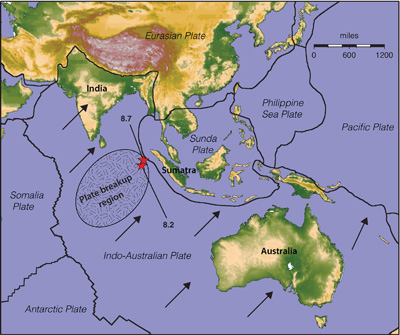Science News
Plate Break-Up
September 27, 2012

“This was one of the weirdest earthquakes we have ever seen. It was like the 1906 San Francisco earthquake, a strike-slip event, but it was huge—15 times more energetic. This earthquake and an 8.2 that followed were in a very diffuse zone in an oceanic plate close to the Sumatra subduction zone, but it wasn’t a single fault that produced the quake, it was a crisscrossing of three or four faults that all ruptured in sequence to make such a big earthquake, and they ruptured deep.”
UC Berkeley’s Roland Burgmann is describing two large earthquakes that occurred in April of this year, in the Indian Ocean, off the coast of Sumatra. While the two ‘quakes caused little damage, the first, measuring magnitude 8.7, was the largest strike-slip temblor ever recorded, and the events seem to be triggering much more than shaking.
Three papers this week in Nature analyze the before, during, and after of the two earthquakes, and all three seem to arrive at the same conclusion: the Indo-Australian tectonic plate is breaking into two separate plates.
If you’ve visited the Academy’s Earthquake exhibit and planetarium show (and you can now do so virtually, through an iTunes course), you know that earthquakes result when continents break apart and plates grind against each other. Scientists say that’s exactly what is happening in this Indo-Australian region right now. Not surprisingly, very slowly.
Thorne Lay, of UC Santa Cruz and co-author on one of the Nature papers, says that the process of forming a new plate boundary will take millions of years and is likely to require hundreds if not thousands of earthquakes like the larger one in April. "This was a huge earthquake, but it's going to happen again and again to make a through-going fracture that separates the plates.”
Lay and his colleagues’ paper analyzes what happened during the 8.7 quake. It appears that it ruptured over a complex network of at least four faults lying at right angles to one another. According to Lay, the energy released on each fault individually was about magnitude 8, adding up to a total event magnitude of 8.7 (a revised estimate higher than the 8.6 value initially reported). The initial shock was followed two hours later by a magnitude 8.2 aftershock on yet another fault to the south.
The paper by Burgmann and his colleagues from the USGS in Menlo Park, takes it from there. The study shows that these two quakes triggered other, distant earthquakes hours and days later. In fact, the seismologists’ analysis found five times the expected number of quakes during the six days following the April 11 quake and aftershock!
“We found a lot of big events around the world, including a 7.0 quake in Baja California and quakes in Indonesia and Japan, that created significant local shaking,” Burgmann says. “If those quakes had been in an urban area, it could potentially have been disastrous.
“Until now, we seismologists have always said, ‘Don’t worry about distant earthquakes triggering local quakes.’ This study now says that, while it is very rare—it may only happen every few decades—it is a real possibility if the right kind of earthquake happens.”
Image: Thorne Lay/UCSC